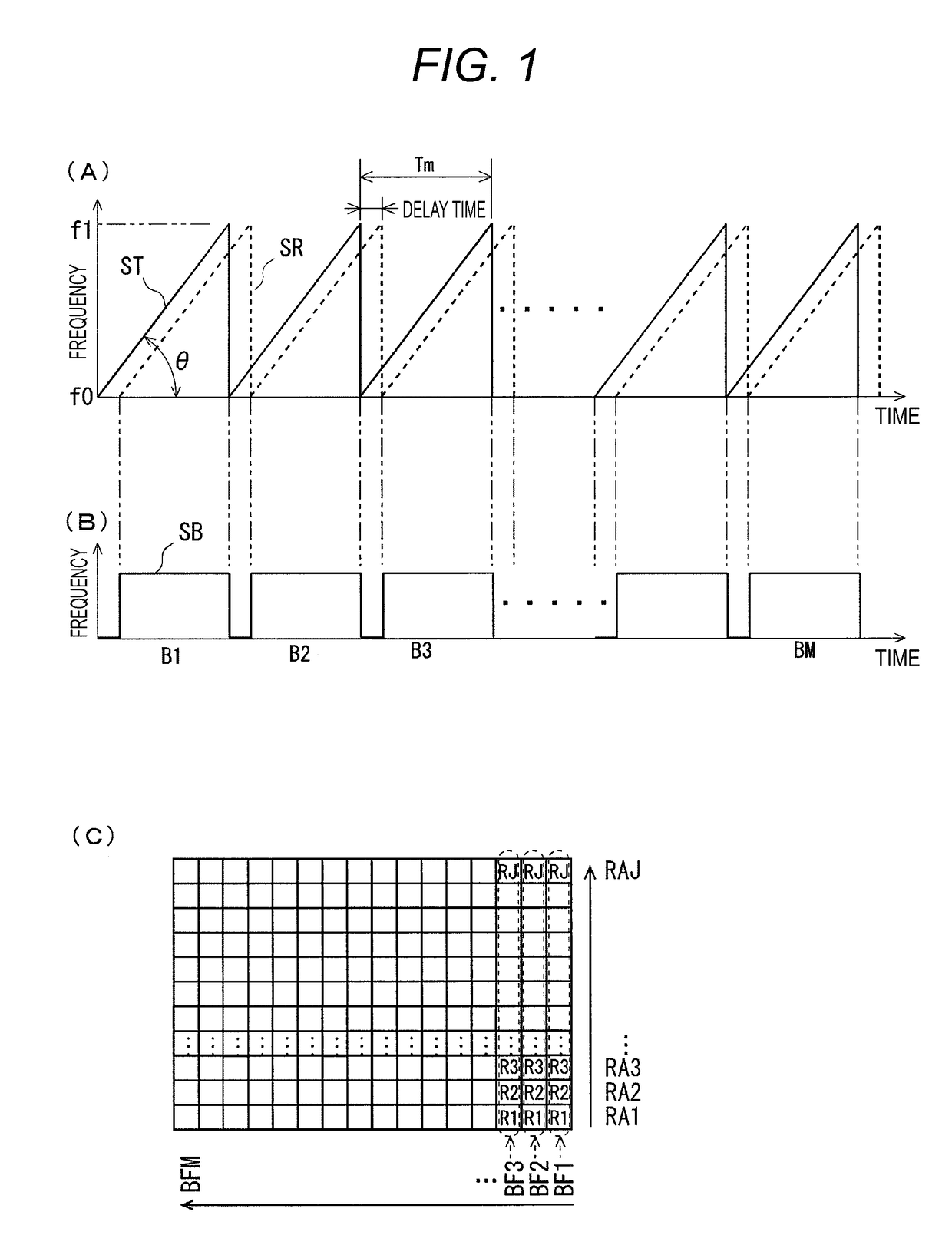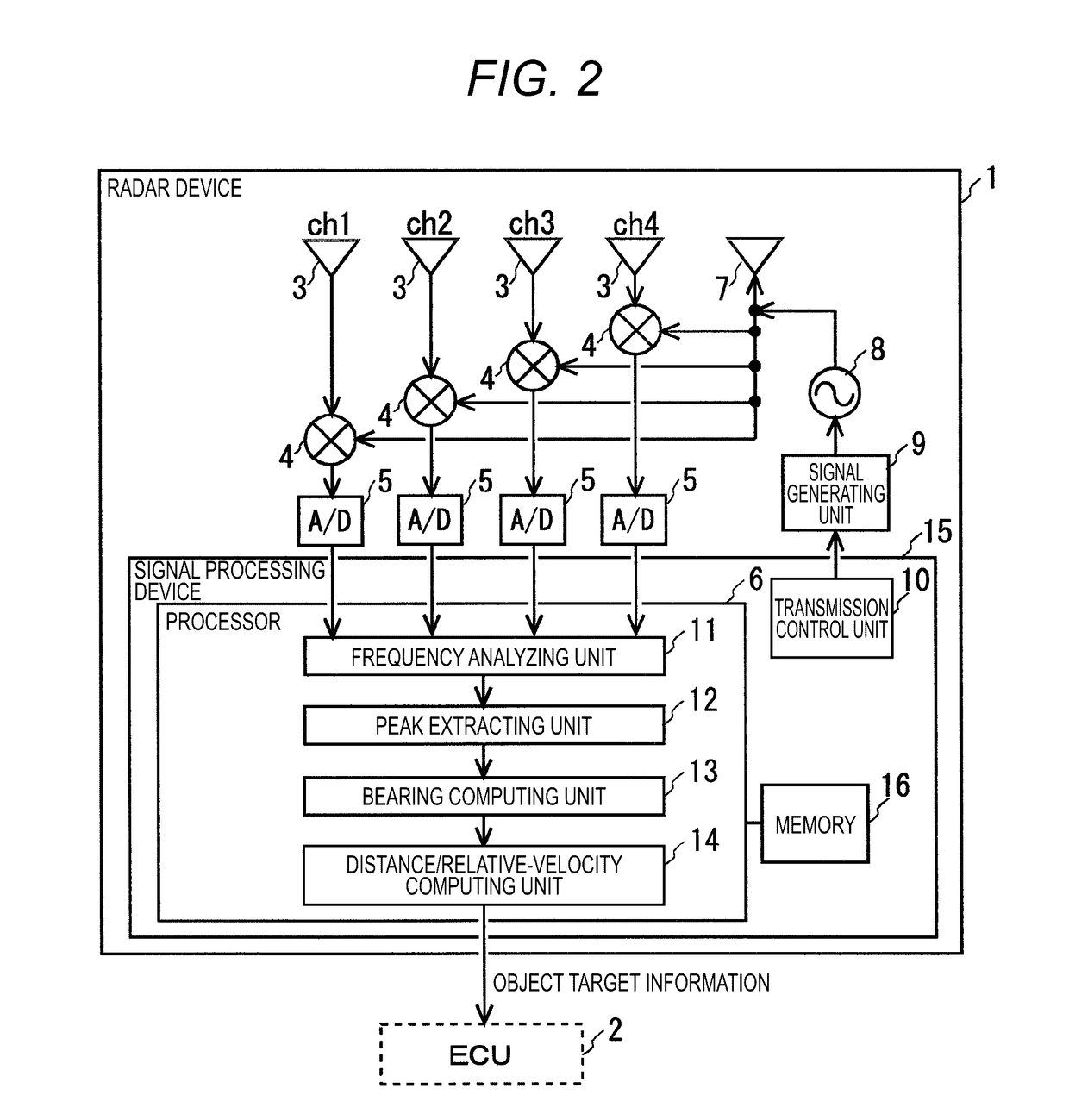Radar device, signal processing device for radar device and velocity measuring method for radar device
a signal processing and radar technology, applied in measurement devices, using reradiation, instruments, etc., can solve the problems of inability to correctly perform velocity measurement and high computation load, so as to reduce computation load, detect accurate relative velocity, and expand detection velocity range
- Summary
- Abstract
- Description
- Claims
- Application Information
AI Technical Summary
Benefits of technology
Problems solved by technology
Method used
Image
Examples
first embodiment
Configuration of Device
[0047]The radar device 1 includes a transmitting antenna 7, an oscillator 8, and a signal generating unit 9. Also, the radar device 1 includes receiving antennae 3 (ch1 to ch4) arranged at regular intervals, mixers 4 (ch1 to ch4) connected to the receiving antennae 3, respectively, A / D (Analog to Digital) converters 5 (ch1 to ch4) connected to the mixers 4, respectively, and a signal processing device 15 configured to process data of the A / D converters 5.
[0048]Alternatively, the radar device 1 may include a receiving circuit dedicated for each receiving antenna, or may be include a receiving circuit configured to collectively receive reception signals of all receiving antennae. In this case, control for performing switching on the receiving antennae is required such that the receiving antennae sequentially correspond to the receiving circuit in a time division manner; however, it is possible to make the circuit configuration of the radar device 1 compact. In t...
second embodiment
[0095]In the first embodiment, an example in which individual parameters having the same velocity resolution Vmin are used to perform measurement has been described. However, in the present invention, an example in which individual parameters having different velocity resolutions Vmin are used to perform measurement is shown. The present embodiment is the same as the first embodiment in the device configuration of FIG. 2, the flow chart of signal processing of FIG. 5, and the like. Therefore, descriptions of identical elements will not be made, and different elements will be mainly described.
[0096]FIG. 11 shows setting examples of parameters having detection velocity ranges Vmax and velocity resolutions Vmin. In the examples of FIG. 11, with respect to the basic parameter, the detection velocity range Vmax is set to 200 km / h, and the velocity resolution Vmin is set to 1 km / h. Also, with respect to the first parameter, the first detection velocity range V1max is set to 200 km / h, and ...
third embodiment
[0122]In a parameter group including at least the first individual parameter and the second individual parameter, a parameter which is the n-th (wherein “n” is a natural number) is referred to as the n-th parameter. In the above described embodiments, an example in which two individual parameters are used, that is, “n” is 1 or 2 has been described. However, the number of parameters is not limited to two, and three or more parameters may be used to perform measurement. The present embodiment is the same as the first and second embodiments in the device configuration of FIG. 2, the flow chart of signal processing of FIG. 5, and the like. Therefore, descriptions of identical elements will not be made, and different elements will be mainly described.
[0123]In a case of performing velocity measurement by combining a plurality of individual parameters, there are two main integration procedures. A first integration procedure is a procedure of obtaining a relative velocity (hereinafter, also...
PUM
 Login to View More
Login to View More Abstract
Description
Claims
Application Information
 Login to View More
Login to View More - R&D
- Intellectual Property
- Life Sciences
- Materials
- Tech Scout
- Unparalleled Data Quality
- Higher Quality Content
- 60% Fewer Hallucinations
Browse by: Latest US Patents, China's latest patents, Technical Efficacy Thesaurus, Application Domain, Technology Topic, Popular Technical Reports.
© 2025 PatSnap. All rights reserved.Legal|Privacy policy|Modern Slavery Act Transparency Statement|Sitemap|About US| Contact US: help@patsnap.com



